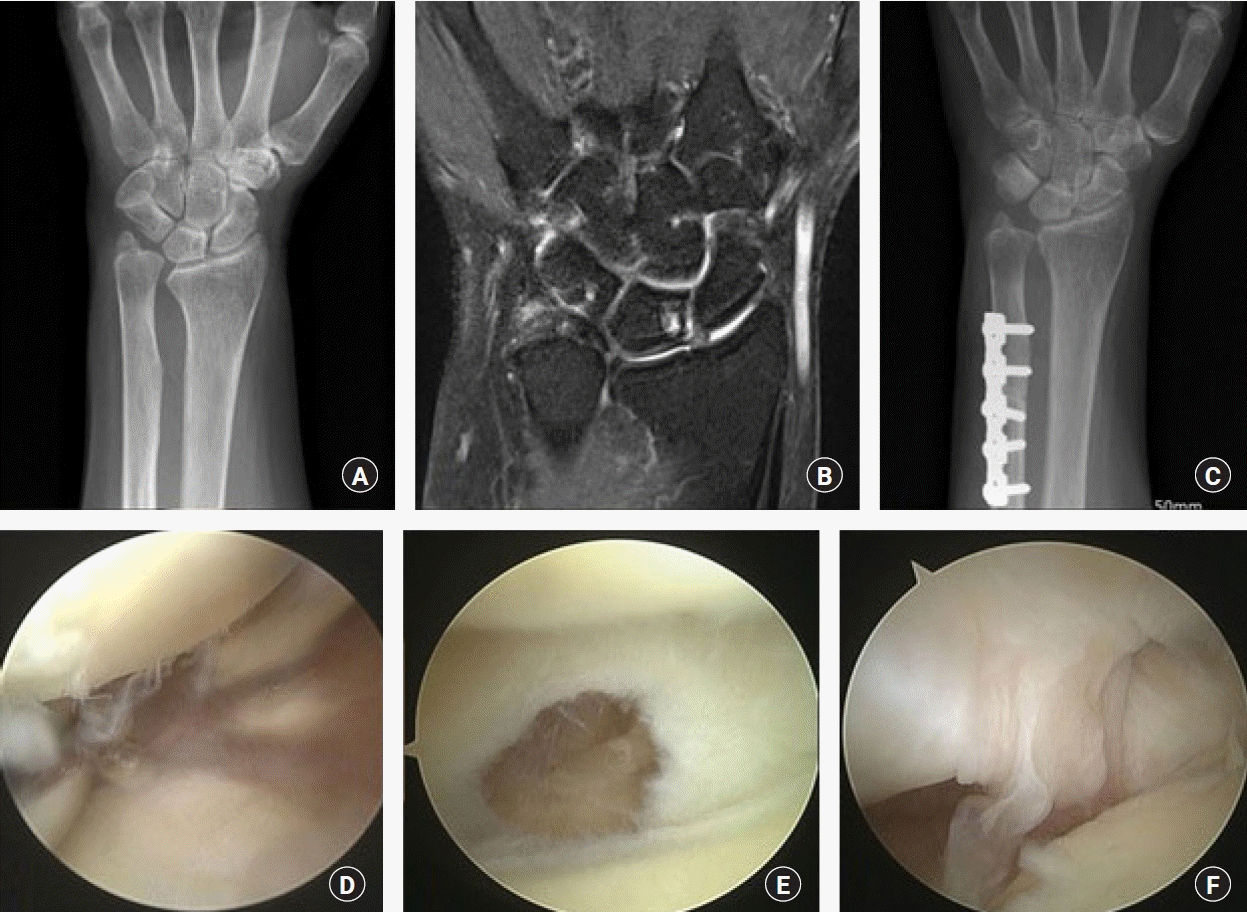1. Friedman SL, Palmer AK. The ulnar impaction syndrome. Hand Clin. 1991; 7:295–310.

2. Bernstein MA, Nagle DJ, Martinez A, Stogin JM Jr, Wiedrich TA. A comparison of combined arthroscopic triangular fibrocartilage complex debridement and arthroscopic wafer distal ulna resection versus arthroscopic triangular fibrocartilage complex debridement and ulnar shortening osteotomy for ulnocarpal abutment syndrome. Arthroscopy. 2004; 20:392–401.

3. Cheon SJ, Kang JH, Cho JY, Lim JM. Treatment of ulnar impaction syndrome using arthroscopy and ulnar shortening osteotomy. J Korean Orthop Assoc. 2007; 42:310–7.

4. Park JW, Kim SK, Park JH, Wang JH, Lee SJ, Jeon WJ. Results of Ulnar Shortening for Ulnar Impaction Syndrome in the Wrist. J Korean Soc Surg Hand. 2006; 11:14–9.
5. Kim BS, Song HS. A comparison of ulnar shortening osteotomy alone versus combined arthroscopic triangular fibrocartilage complex debridement and ulnar shortening osteotomy for ulnar impaction syndrome. Clin Orthop Surg. 2011; 3:184–90.

6. Baek GH, Chung MS, Lee YH, Jeong GI, Lee CH. Arthroscopy of the wrist and ulnar shortening osteotomy for the treatment of the ulnar impaction syndrome. J Korean Orthop Assoc. 2001; 36:207–14.

7. Sachar K. Ulnar-sided wrist pain: evaluation and treatment of triangular fibrocartilage complex tears, ulnocarpal impaction syndrome, and lunotriquetral ligament tears. J Hand Surg Am. 2008; 33:1669–79.

8. Imaeda T, Nakamura R, Shionoya K, Makino N. Ulnar impaction syndrome: MR imaging findings. Radiology. 1996; 201:495–500.

9. Escobedo EM, Bergman AG, Hunter JC. MR imaging of ulnar impaction. Skeletal Radiol. 1995; 24:85–90.

10. Minami A, Ishikawa J, Suenaga N, Kasashima T. Clinical results of treatment of triangular fibrocartilage complex tears by arthroscopic debridement. J Hand Surg Am. 1996; 21:406–11.

11. Kreder HJ, Hanel DP, McKee M, Jupiter J, McGillivary G, Swiontkowski MF. X-ray film measurements for healed distal radius fractures. J Hand Surg Am. 1996; 21:31–9.

12. Palmer AK. Triangular fibrocartilage complex lesions: a classification. J Hand Surg Am. 1989; 14:594–606.

13. Chun S, Palmer AK. The ulnar impaction syndrome: follow-up of ulnar shortening osteotomy. J Hand Surg Am. 1993; 18:46–53.

14. Cerezal L, del Pinal F, Abascal F, Garcia-Valtuille R, Pereda T, Canga A. Imaging findings in ulnar-sided wrist impaction syndromes. Radiographics. 2002; 22:105–21.

15. Loh YC, Van Den Abbeele K, Stanley JK, Trail IA. The results of ulnar shortening for ulnar impaction syndrome. J Hand Surg Br. 1999; 24:316–20.

16. Hobby JL, Tom BD, Bearcroft PW, Dixon AK. Magnetic resonance imaging of the wrist: diagnostic performance statistics. Clin Radiol. 2001; 56:50–7.

17. Magee T. Comparison of 3-T MRI and arthroscopy of intrinsic wrist ligament and TFCC tears. AJR Am J Roentgenol. 2009; 192:80–5.

18. Koh KH, Lee HL, Chang YS, Park MJ. Arthroscopy during ulnar shortening for idiopathic ulnar impaction syndrome. Orthopedics. 2013; 36:e1495–500.

19. Park JC, Sur YJ, Rhee SK, Song SW, Lee SM, Han SH. Ulnar shortening osteotomy for the treatment of ulnar impaction syndrome. J Korean Soc Surg Hand. 2009; 14:172–8.
20. Roh YH, Song JH, Gong HS, Baek GH. Comparison of clinical outcomes after ulnar shortening osteotomy for ulnar impaction syndrome with or without arthroscopic debridement. J Hand Surg Eur Vol. 2019; 44:589–93.
21. Tatebe M, Shinohara T, Okui N, Yamamoto M, Hirata H, Imaeda T. Clinical, radiographic, and arthroscopic outcomes after ulnar shortening osteotomy: a long-term follow-up study. J Hand Surg Am. 2012; 37:2468–74.

22. Low S, Herold A, Unglaub F, Megerle K, Erne H. Treatment of ulnar impaction syndrome with and without central TFC lesion. J Wrist Surg. 2018; 7:133–40.
23. Hulsizer D, Weiss AP, Akelman E. Ulna-shortening osteotomy after failed arthroscopic debridement of the triangular fibrocartilage complex. J Hand Surg Am. 1997; 22:694–8.

24. Ruch DS, Poehling GG. Arthroscopic management of partial scapholunate and lunotriquetral injuries of the wrist. J Hand Surg Am. 1996; 21:412–7.

25. Westkaemper JG, Mitsionis G, Giannakopoulos PN, Sotereanos DG. Wrist arthroscopy for the treatment of ligament and triangular fibrocartilage complex injuries. Arthroscopy. 1998; 14:479–83.

26. Weiss AP, Sachar K, Glowacki KA. Arthroscopic debridement alone for intercarpal ligament tears. J Hand Surg Am. 1997; 22:344–9.








 PDF
PDF Citation
Citation Print
Print



 XML Download
XML Download